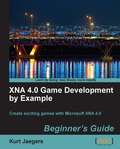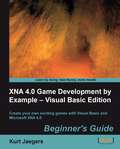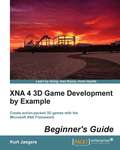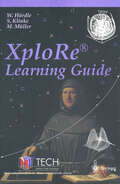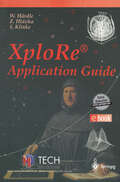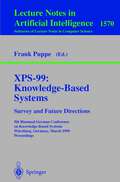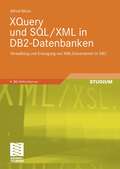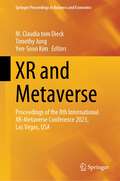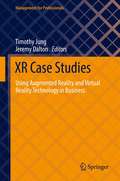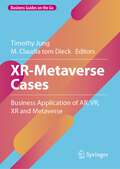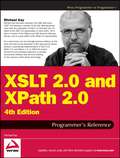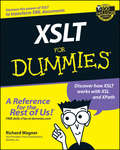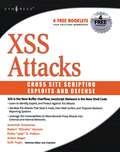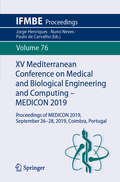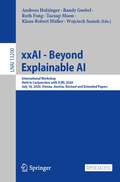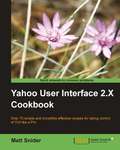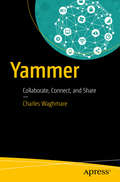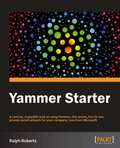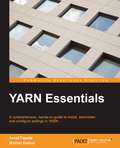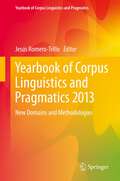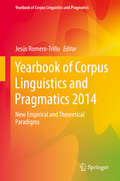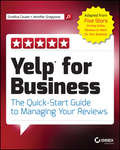- Table View
- List View
XNA 4.0 Game Development by Example: Beginner's Guide
by Kurt JaegersThis book is a step-by-step tutorial that includes complete source code for all of the games covered. It adopts an engaging style to teach all the game development concepts. Each block of code is explained, and game development concepts are diagrammed and covered in detail. Each game begins with a concept description and concludes with suggestions for expanding on the finished game. If you are an aspiring game developer who wants to take a shot at creating games for the Microsoft Windows platform with the XNA Framework, then this book is for you. Using this book, you can get started with creating games without any game development experience. A basic knowledge of C# would be helpful to kick-start your game development, but it's not essential.
XNA 4.0 Game Development by Example: Beginner's Guide - Visual Basic Edition Beginner's Guide
by Kurt JaegersIn DetailXNA Game Studio enables hobbyists and independent game developers to easily create video games, and now gives that power to Visual Basic developers. XNA lets you bring your creations to life on Windows, the Xbox 360 and the Windows Phone platforms. The latest release of XNA has added support to Visual Basic and therefore, Visual Basic developers now have the power to give life to their creativity with XNA.This book covers both the concepts and the implementations necessary to get you started on bringing your own creations to life with XNA. It presents four different games, including a puzzler, space shooter, multi-axis shoot 'em up, and a jump-and-run platformer. Each game introduces new concepts and techniques to build a solid foundation for your own ideas and creativity.This book details the creation of four games, all in different styles, from start to finish using Visual Basic and the Microsoft XNA framework. Beginning with the basics of drawing images to the screen, the book then incrementally introduces sprite animation, particles, sound effects, tile-based maps, and path finding. It then explores combining XNA with Windows Forms to build an interactive map editor, and builds a platform-style game using the editor-generated maps. Finally, the book covers the considerations necessary for deploying your games to the Xbox 360 platform.By the end of the book, you will have a solid foundation of game development concepts and techniques as well as working sample games to extend and innovate upon. You will have the knowledge necessary to create games that you can complete without an army of fellow game developers at your back.A step-by-step tutorial for using Visual Basic with Microsoft XNA to create four different styles of video games.ApproachThis book is a step-by-step tutorial that includes complete source code for all of the games covered. It adopts an engaging style to teach all the game development concepts. Each block of code is explained, and game development concepts are diagrammed and covered in detail. Each game begins with a concept description and concludes with suggestions for expanding on the finished game.Who this book is forIf you are an aspiring game developer who wants to take a shot at creating games for the Microsoft Windows platform with the XNA Framework, then this book is for you. Using this book, you can get started with creating games without any game development experience. A basic knowledge of Visual Basic would be needed to kickstart your game development.
XNA 4 3D Game Development by Example Beginner's Guide: Beginner's Guide
by Kurt JaegersIn DetailMove beyond the world of flat 2D-based game development and discover how to create your own exciting 3D games with Microsoft XNA 4.0. Create a 3D maze, fire shells at enemy tanks, and drive a rover on the surface of Mars while being attacked by alien saucers."XNA 4 3D Game Development by Example: Beginner's Guide" takes you step-by-step through the creation of three different 3D video games with Microsoft XNA 4.0. Learn by doing as you explore the worlds of 3D graphics and game design.This book takes a step-by-step approach to building 3D games with Microsoft XNA, describing each section of code in depth and explaining the topics and concepts covered in detail. From the basics of a 3D camera system to an introduction to writing DirectX shader code, the games in this book cover a wide variety of both 3D graphics and game design topics. Generate random mazes, load and animate 3D models, create particle-based explosions, and combine 2D and 3D techniques to build a user interface."XNA 4 3D Game Development by Example: Beginner's Guide" will give you the knowledge to bring your own 3D game creations to life.ApproachThis book is a step-by-step tutorial that includes complete source code for all of the games covered. It adopts an engaging style to teach all the game development concepts. Each block of code is explained, and game development concepts are diagrammed and covered in detail. Each game begins with a concept description and concludes with suggestions for expanding on the finished game.Who this book is forThis book is intended for readers who want to create 3D games using the XNA Framework. Basic knowledge of the C# programming language and 2D XNA concepts are helpful, but not required.
XploRe — Learning Guide: Learning Guide
by W. Härdle S. Klinke M. MüllerIt is generally accepted that training in statistics must include some exposure to the mechanics of computational statistics. This learning guide is intended for beginners in computer-aided statistical data analysis. The prerequisites for XploRe - the statistical computing environment - are an introductory course in statistics or mathematics. The reader of this book should be familiar with basic elements of matrix algebra and the use of HTML browsers. This guide is designed to help students to XploRe their data, to learn (via data interaction) about statistical methods and to disseminate their findings via the HTML outlet. The XploRe APSS (Auto Pilot Support System) is a powerful tool for finding the appropriate statistical technique (quantlet) for the data under analysis. Homogeneous quantlets are combined in XploRe into quantlibs. The XploRe language is intuitive and users with prior experience of other sta tistical programs will find it easy to reproduce the examples explained in this guide. The quantlets in this guide are available on the CD-ROM as well as on the Internet. The statistical operations that the student is guided into range from basic one-dimensional data analysis to more complicated tasks such as time series analysis, multivariate graphics construction, microeconometrics, panel data analysis, etc. The guide starts with a simple data analysis of pullover sales data, then in troduces graphics. The graphics are interactive and cover a wide range of dis plays of statistical data.
XploRe® - Application Guide
by W. Härdle Z. Hlavka S. KlinkeThis book offers a detailed application guide to XploRe - an interactive statistical computing environment. As a guide it contains case studies of real data analysis situations. It helps the beginner in statistical data analysis to learn how XploRe works in real life applications. Many examples from practice are discussed and analysed in full length. Great emphasis is put on a graphic based understanding of the data interrelations. The case studies include: Survival modelling with Cox's proportional hazard regression, Vitamin C data analysis with Quantile Regression, and many others.
XPS-99: 5th Biannual German Conference on Knowledge-Based Systems, Würzburg, Germany, March 3-5, 1999, Proceedings (Lecture Notes in Computer Science #1570)
by Frank PuppeA special year like 1999 invites one to draw a balance of what has been achieved in the roughly 30 years of research and development in knowledge based systems (still abbreviated as XPS following the older term “expert systems”) and to take a look at th what the future may hold. For the 5 German conference on knowledge-based systems we therefore asked current and former speakers of the four working groups (FG’s) in the subdivision of knowledge-based systems (FA 1.5) of the German association of Informatics (GI) to present a survey of and future prospects for their respective fields: knowledge engineering, diagnosis, configuration, and case-based reasoning. An additional 14 technical papers deal with current topics in knowledge-based systems with an equal emphasis on methods and applications. They are selected from more than 50 papers accepted in the 4 parallel workshops of XPS-99: a) Knowledge Management, Organizational Memory and Reuse, b) various fields of applications, c) the traditional PuK Workshop (planning and configuration), and d) the GWCBR (German workshop on case-based reasoning). The other papers presented at these workshops are not included in this volume but are available as internal reports of Würzburg university together with the exhibition guide that emphasizing tool support for building knowledge based systems.
XQuery und SQL/XML in DB2-Datenbanken: Verwaltung und Erzeugung von XML-Dokumenten in DB2
by Alfred MoosIn den modernen universellen Datenbanken ist die Verwaltung von herkömmlichen Daten und die Verwaltung von XML-Dokumenten zusammengewachsen. Jeder zukunftsorientierte Informatiker benötigt über die neuen Möglichkeiten zumindest mittelmäßige Kenntnisse oder noch besser profunde Qualifikationen. Dokumente sind, im Gegensatz zu herkömmlichen relationalen Daten, hierarchische Baumstrukturen. Der Umgang mit ihnen verlangt von Informatikern eine neue hierarchische Denkweise. Ihre systematische Einführung und Einübung mit den gebotenen Möglichkeiten von SQL3 und XQuery in DB2 ist zentraler Gegenstand des Buches.
XR and Metaverse: Proceedings of the 8th International XR-Metaverse Conference 2023, Las Vegas, USA (Springer Proceedings in Business and Economics)
by M. Claudia tom Dieck Timothy Jung Yen-Soon KimThis book offers a comprehensive collection of the latest research presented at the 8th International XR-Metaverse Conference, held in Las Vegas, USA in 2023. Its goal is to bridge the gap between academia and industry by advancing the state of the art in metaverse, XR, AI-based AR and VR technologies, and by exploring their applications in various fields such as business, marketing, education, health care, tourism, events, fashion, entertainment, retail, and the gaming industry. Including contributions by prominent XR scholars from around the globe, the book addresses a wide range of significant topics concerning XR and the metaverse. Showcasing cutting-edge research outputs, it will be of interest to both academics and practitioners eager to catch up on the latest developments in this rapidly evolving field.
XR Case Studies: Using Augmented Reality and Virtual Reality Technology in Business (Management for Professionals)
by Timothy Jung Jeremy DaltonThis book presents a comprehensive collection of case studies on augmented reality and virtual realty (AR/VR) applications in various industries. Augmented reality and virtual reality are changing the business landscape, providing opportunities for businesses to offer unique services and experiences to their customers. The case studies provided in this volume explore business uses of the technology across multiple industries such as healthcare, tourism, hospitality, events, fashion, entertainment, retail, education and video gaming. The book includes solutions of different maturities as well as those from startups to large enterprises thereby providing a thorough view of how augmented reality and virtual reality can be used in business.
XR Development with Unity: A beginner's guide to creating virtual, augmented, and mixed reality experiences using Unity
by Anna Braun Raffael RizzoCreate VR, AR, and MR experiences with the help of step-by-step tutorials on VR and AR simulators, interactivity, sound and visual effects, along with advanced XR techniques such as multiplayer integrationKey FeaturesCreate impressive XR projects without the need to own expensive VR headsetsExplore Unity XR features and techniques such as hand-tracking and plane detection using the XR Interaction Toolkit and AR FoundationBring your XR projects to life with step-by-step explanations along with practical examplesPurchase of the print or Kindle book includes a free PDF eBookBook DescriptionThe drastic surge in the demand for XR development has led to an imminent need for comprehensive resources, learning material, and overall know-how in this area. This one-stop resource will ensure that professionals venturing into XR development can access all XR-related techniques to build appealing XR applications, without relying on Google every step of the way. This book is your guide to developing XR applications with Unity 2021.3 or later versions, helping you to create VR, AR, and MR experiences of increasing complexity. The chapters cover the entire XR application development process from setting up an interactive XR scene using the XR Interaction Toolkit or AR Foundation, adding physics, animations, continuous movement, teleportation, sound effects, and visual effects, to testing and deploying to VR headsets, simulators, smartphones, and tablets. Additionally, this XR book takes you on a journey from the basics of Unity and C# to advanced techniques such as building multiplayer applications and incorporating hand- and gaze-tracking capabilities. By the end of this book, you'll be fully equipped to create cutting-edge XR projects for engaging individual, academic, and industrial use cases that captivate your audience.What you will learnGet started with Unity by building your own 3D projectExplore the XR Interaction Toolkit and AR Foundation, as well as test XR applications on your PCFind out how to deploy XR projects on different platformsBuild interactive XR apps with increasing degrees of complexity by leveraging C# scriptingCreate a fully immersive VR drum scene by using Unity’s audio and particle systemsAdd advanced XR techniques such as hand-tracking, gaze-tracking, and multiplayer capabilities to your XR appsWho this book is forThis book is for students, developers, researchers, and professionals with a background in computer science. Business analysts, PMs, and other management professionals and executives will also benefit from this book. If you have basic knowledge of programming and are looking to gain expertise in creating virtual reality and augmented reality applications in Unity, then this book is for you. While having experience as a VR game player with basic programming knowledge can enhance your understanding of the content, it is not a prerequisite.
XR-Metaverse Cases: Business Application of AR, VR, XR and Metaverse (Business Guides on the Go)
by Timothy Jung M. Claudia tom DieckThis book presents a collection of latest case studies on augmented reality (AR) and virtual reality (VR), extended reality (XR) and metaverse applications in various industries. AR, VR, XR and Metaverse are changing the business landscape, providing opportunities for businesses to offer unique services and experiences to their customers. The case studies explore business uses of the technology across multiple industries such as healthcare, tourism, hospitality, events, fashion, entertainment, retail, education and video gaming. The volume includes solutions of different maturities as well as those from startups to large enterprises thereby providing a thorough view of how AR, VR, XR and Metaverse can be used in business.
XSLT 2.0 and XPath 2.0 Programmer's Reference
by Michael KayCombining coverage of both XSLT 2.0 and XPath 2.0, this book is the definitive reference to the final recommendation status versions of both specifications. The authors start by covering the concepts in XSLT and XPath, and then delve into elements, operators, expressions with syntax, usage, and examples. Some of the specific topics covered include XSLT processing model, stylesheet structure, serialization, extensibility, and many others. In addition to online content that includes error codes, the book also has case studies you'll find applicable to your own challenges.
XSLT 2.0 and XPath 2.0 Programmer's Reference
by Michael KayCombining coverage of both XSLT 2.0 and XPath 2.0, this book is the definitive reference to the final recommendation status versions of both specifications. The authors start by covering the concepts in XSLT and XPath, and then delve into elements, operators, expressions with syntax, usage, and examples. Some of the specific topics covered include XSLT processing model, stylesheet structure, serialization, extensibility, and many others. In addition to online content that includes error codes, the book also has case studies you'll find applicable to your own challenges.
XSLT For Dummies (For Dummies Ser.)
by Richard WagnerRestructuring information in an XML document so that it works in other formats used to be a time-consuming ordeal involving lots of blood, sweat, and tears. Now XSLT (Extensible Stylesheet Language Transformations) makes the process nearly instantaneous. Just provide an example of the kind of information you’d like to see, and XSLT does the rest. With XSLT you can effortlessly transform XML documents into virtually any kind of output, including other XML documents and HTML pages. But mastering XSLT can be tricky, especially if you’ve never worked with XML or HTML; and most books on the subject are written for people who have. Here comes XSLT For Dummies to the rescue! XSLT For Dummies is your ticket to quickly mastering XSLT—no matter what your prior programming experience. Writing in easygoing, plain English, XML pro Richard Wagner provides expert advice, step-by-step guidance, and tons of crystal-clear examples to help you harness the power of XSLT to transform documen ts. In no time you’ll: Understand how XSLT works with XSL and XPath Experiment with templates, stylesheets, and expressions Perform HTML transformations Master XPath data types and functions Combine XSLT stylesheets Explore cool XSLT programming tricks XSLT For Dummies works from the ground up, starting with a practical introduction of the “X-Team”—XML, XSL, XSLT, and X-Path—and instructions on how to write a XSLT stylesheet. From there it quickly moves onward and upward through the whole range of important XSLT topics, including: Transforming with stylesheets Understanding and using template rules Using XPath to locate nodes in XML documents Combining XSLT stylesheets and adding processing instructions Debugging XSLT transformations Ten XSLT processors available online It doesn’t matter whether you’re a babe in the woods who can’t tell a “tag” from an element, or you’re an old pro at creating XML documents, XSLT For Dummies offers you a fun, easy way to explore and take full advantage of Extensible Stylesheet Language Transformations.
XSS Attacks: Cross Site Scripting Exploits and Defense
by Seth Fogie Jeremiah Grossman Robert Hansen Anton Rager Petko D. PetkovA cross site scripting attack is a very specific type of attack on a web application. It is used by hackers to mimic real sites and fool people into providing personal data.XSS Attacks starts by defining the terms and laying out the ground work. It assumes that the reader is familiar with basic web programming (HTML) and JavaScript. First it discusses the concepts, methodology, and technology that makes XSS a valid concern. It then moves into the various types of XSS attacks, how they are implemented, used, and abused. After XSS is thoroughly explored, the next part provides examples of XSS malware and demonstrates real cases where XSS is a dangerous risk that exposes internet users to remote access, sensitive data theft, and monetary losses. Finally, the book closes by examining the ways developers can avoid XSS vulnerabilities in their web applications, and how users can avoid becoming a victim. The audience is web developers, security practitioners, and managers.XSS Vulnerabilities exist in 8 out of 10 Web sitesThe authors of this book are the undisputed industry leading authoritiesContains independent, bleeding edge research, code listings and exploits that can not be found anywhere else
XV Mediterranean Conference on Medical and Biological Engineering and Computing – MEDICON 2019: Proceedings of MEDICON 2019, September 26-28, 2019, Coimbra, Portugal (IFMBE Proceedings #76)
by Jorge Henriques Nuno Neves Paulo De CarvalhoThis book gathers the proceedings of MEDICON 2019 – the XV Mediterranean Conference on Medical and Biological Engineering and Computing – which was held in September 26-28, 2019, in Coimbra, Portugal. A special emphasis has been given to practical findings, techniques and methods, aimed at fostering an effective patient empowerment, i.e. to position the patient at the heart of the health system and encourages them to be actively involved in managing their own healthcare needs. The book reports on research and development in electrical engineering, computing, data science and instrumentation, and on many topics at the interface between those disciplines. It provides academics and professionals with extensive knowledge on cutting-edge techniques and tools for detection, prevention, treatment and management of diseases. A special emphasis is given to effective advances, as well as new directions and challenges towards improving healthcare through holistic patient empowerment.
xxAI - Beyond Explainable AI: International Workshop, Held in Conjunction with ICML 2020, July 18, 2020, Vienna, Austria, Revised and Extended Papers (Lecture Notes in Computer Science #13200)
by Andreas Holzinger Randy Goebel Ruth Fong Taesup Moon Klaus-Robert Müller Wojciech SamekThis is an open access book.Statistical machine learning (ML) has triggered a renaissance of artificial intelligence (AI). While the most successful ML models, including Deep Neural Networks (DNN), have developed better predictivity, they have become increasingly complex, at the expense of human interpretability (correlation vs. causality). The field of explainable AI (xAI) has emerged with the goal of creating tools and models that are both predictive and interpretable and understandable for humans. Explainable AI is receiving huge interest in the machine learning and AI research communities, across academia, industry, and government, and there is now an excellent opportunity to push towards successful explainable AI applications. This volume will help the research community to accelerate this process, to promote a more systematic use of explainable AI to improve models in diverse applications, and ultimately to better understand how current explainable AI methods need to be improved and what kind of theory of explainable AI is needed. After overviews of current methods and challenges, the editors include chapters that describe new developments in explainable AI. The contributions are from leading researchers in the field, drawn from both academia and industry, and many of the chapters take a clear interdisciplinary approach to problem-solving. The concepts discussed include explainability, causability, and AI interfaces with humans, and the applications include image processing, natural language, law, fairness, and climate science.
Yahoo User Interface 2.x Cookbook
by Matt SniderIn DetailThe Yahoo! User Interface (YUI) Library is a set of utilities and controls, written in JavaScript, for building richly interactive web applications using techniques such as DOM scripting, DHTML, and AJAX. Although you can create stylish Internet applications by modifying its default components, even advanced users find it challenging to create impressive feature-rich Internet applications using YUI.This book will help you learn how to use YUI 2.x to build richer, more interactive web applications that impress clients and wow your friends. It has recipes explaining over twenty-five YUI components, showing how to use them, and how to configure them to meet your needs. Each covered component will have extractable code samples that showcase the common ways that the component is used.The book starts by explaining the core features of YUI 2.x, the utilities that the rest of the library depends on and that will make your life easier. It then explains how to build UI components and make AJAX requests using the YUI framework. Each recipe will cover the most common ways to use a component, how to configure it, and then explain any other features that may be available. We wrap things up by looking at some of the recent beta components and explain how to use them, and how they may be useful on your web application.For each of the recipes, there is an introductory example, then more advanced examples, followed by an explanation of how the component works and what YUI is doing. For more experienced developers, most recipes also include additional discussion of the solution, explaining to further customize and enhance the component.This practical book, packed with easy-to-follow recipes, will help you create modern rich internet applications using the most powerful components of Yahoo! User Interface Library (YUI)ApproachThis book contains recipes that showcase the common components of YUI, providing suggested examples of use, and a detailed explanation. Except for the first three chapters, which cover the 3 components of YUI that form the foundation for all other components, this book is not meant to be read cover-to-cover. Each recipe is presented as a separate, standalone entity and reading of other prior recipes is not required. Each chapter tackles a particular component or set of related components, introducing the component and explaining how to use it.Who this book is forIf you are a web application developer and have some prior experience with or interest in using YUI 2.x to improve the UI of their web applications, then this book is for you. It assumes the reader has prior knowledge of JavaScript, HTML, CSS, and basic understanding of how a website works. This book provides an easy-to-use guide for implementing YUI 2.x components, and does not require an expertise in either JavaScript or YUI.
Yammer: Collaborate, Connect, and Share
by Charles WaghmareBuild a successful Yammer implementation, make your workplace social and collaborative, create a culture of sharing, form expert communities and generate innovative solutions. Besides, this book will help to enhance your collaboration your suppliers, partners, and clients. The author starts by giving an introduction to social collaborations and successful implementations of Yammer. Along the way, he explains the art of community management in Yammer using his hands-on experience of building communities. He then explains methods to keep a Yammer network engaged followed by a description of running a campaign on Yammer. The second part of Yammer begins with ways you can engage entire organizations, including executives, on Yammer along with methods to measure the success of a Yammer network. You’ll see how to get to grips with integrating Yammer with an existing platform and how to collaborate with customers, suppliers, and partners using Yammer. Finally, you’ll learn various innovative techniques of communication using Yammer and explore the author’s vision of the next-generation Yammer platform After reading this book you will understand how to make successful Yammer implementations, engage communities on Yammer, and accomplish business goals using Yammer.What You Will LearnMaster the art of community managementMake your organization digital by implementing and integrating Yammer Break silos and create a collaborative workforceKeep Yammer groups live and full of participationImprove collaboration between suppliers, partners, and clientsMeasure the success of your Yammer networkIncrease employee engagement on Yammer Who This Book Is ForYammer adoption managers, community managers, customer success managers, and Yammer group admins.
Yammer Starter
by Ralph RobertsThis book is an introduction to Yammer which uses simple but enjoyable terms, informing you how to get the best out of Yammer while enjoying the process. The "Yammer Starter" and Yammer itself requires very little advance knowledge. Most of us have already posted something, sometime on the Internet. Most of us have already used Facebook or one of the other many social media networks, or seen someone using them, and so on. Yammer is that simple. The "Yammer Starter Guide" builds on this basic familiarity, getting you up to speed in using Yammer quickly and easily.
YARN Essentials
by Amol Fasale Nirmal KumarIf you have a working knowledge of Hadoop 1.x but want to start afresh with YARN, this book is ideal for you. You will be able to install and administer a YARN cluster and also discover the configuration settings to fine-tune your cluster both in terms of performance and scalability. This book will help you develop, deploy, and run multiple applications/frameworks on the same shared YARN cluster.
Yearbook of Corpus Linguistics and Pragmatics 2013: New Domains and Methodologies (Yearbook of Corpus Linguistics and Pragmatics #1)
by Jesús Romero-TrilloThe Yearbook of Corpus Linguistics and Pragmatics 2013 discusses current methodological debates on the synergy of Corpus Linguistics and Pragmatics research. The volume presents insightful pragmatic analyses of corpora in new technological domains and devotes some chapters to the pragmatic description of spoken corpora from various theoretical traditions. The Yearbook of Corpus Linguistics and Pragmatics series will give readers insight into how pragmatics can be used to explain real corpus data, and, in addition, how corpora can explain pragmatic intuitions, and from there, develop and refine theory. Corpus Linguistics can offer a meticulous methodology based on mathematics and statistics, while Pragmatics is characterized by its efforts to interpret intended meaning in real language. This yearbook offers a platform to scholars who combine both research methodologies to present rigorous and interdisciplinary findings about language in real use.
Yearbook of Corpus Linguistics and Pragmatics 2014: New Empirical and Theoretical Paradigms (Yearbook of Corpus Linguistics and Pragmatics #2)
by Jesús Romero-TrilloThe Yearbook of Corpus Linguistics and Pragmatics addresses the interface between the two disciplines and offers a platform to scholars who combine both methodologies to present rigorous and interdisciplinary findings about language in real use. Corpus linguistics and Pragmatics have traditionally represented two paths of scientific thought, parallel but often mutually exclusive and excluding. Corpus Linguistics can offer a meticulous methodology based on mathematics and statistics, while Pragmatics is characterized by its effort in the interpretation of intended meaning in real language. This series will give readers insight into how pragmatics can be used to explain real corpus data and also, how corpora can illustrate pragmatic intuitions.The present volume, Yearbook of Corpus Linguistics and Pragmatics 2014: New Empirical and Theoretical Paradigms in Corpus Pragmatics, proposes innovative research models in the liaison between pragmatics and corpus linguistics to explain language in current cultural and social contexts.
Yelp for Business: The Quick-Start Guide to Managing Your Reviews
by Gradiva Couzin Jennifer GrapponeWhile most businesses know the importance of online reviews on sites such as Yelp.com, they have no clue how to grab the reins and help shape the conversation around their service or product. This guide will help users begin crafting and managing a winning presence on the Yelp reviews platform. It opens with a chapter outlining the opportunity for businesses of all types so that everyone understands how reviews affect the bottom line. The book then explores Yelp's demographics and then shows how to best use Yelp's features, including how to claim your business listing and craft a compelling presence. The compelling e-book also includes information about how to communicate with reviewers, how to receive and respond to alerts when new reviews—good or bad—are posted, and when paid membership and promotional options should be considered. It’s a great introduction to the crucial Yelp reviews platform and will also include promotion and a coupon for the upcoming Five Stars: Putting Online Reviews to Work for Your Business book (January 2014).
Yelp for Business: The Quick-Start Guide to Managing Your Reviews
by Gradiva Couzin Jennifer GrapponeWhile most businesses know the importance of online reviews on sites such as Yelp.com, they have no clue how to grab the reins and help shape the conversation around their service or product. This guide will help users begin crafting and managing a winning presence on the Yelp reviews platform. It opens with a chapter outlining the opportunity for businesses of all types so that everyone understands how reviews affect the bottom line. The book then explores Yelp's demographics and then shows how to best use Yelp's features, including how to claim your business listing and craft a compelling presence. The compelling e-book also includes information about how to communicate with reviewers, how to receive and respond to alerts when new reviews—good or bad—are posted, and when paid membership and promotional options should be considered. It’s a great introduction to the crucial Yelp reviews platform and will also include promotion and a coupon for the upcoming Five Stars: Putting Online Reviews to Work for Your Business book (January 2014).
